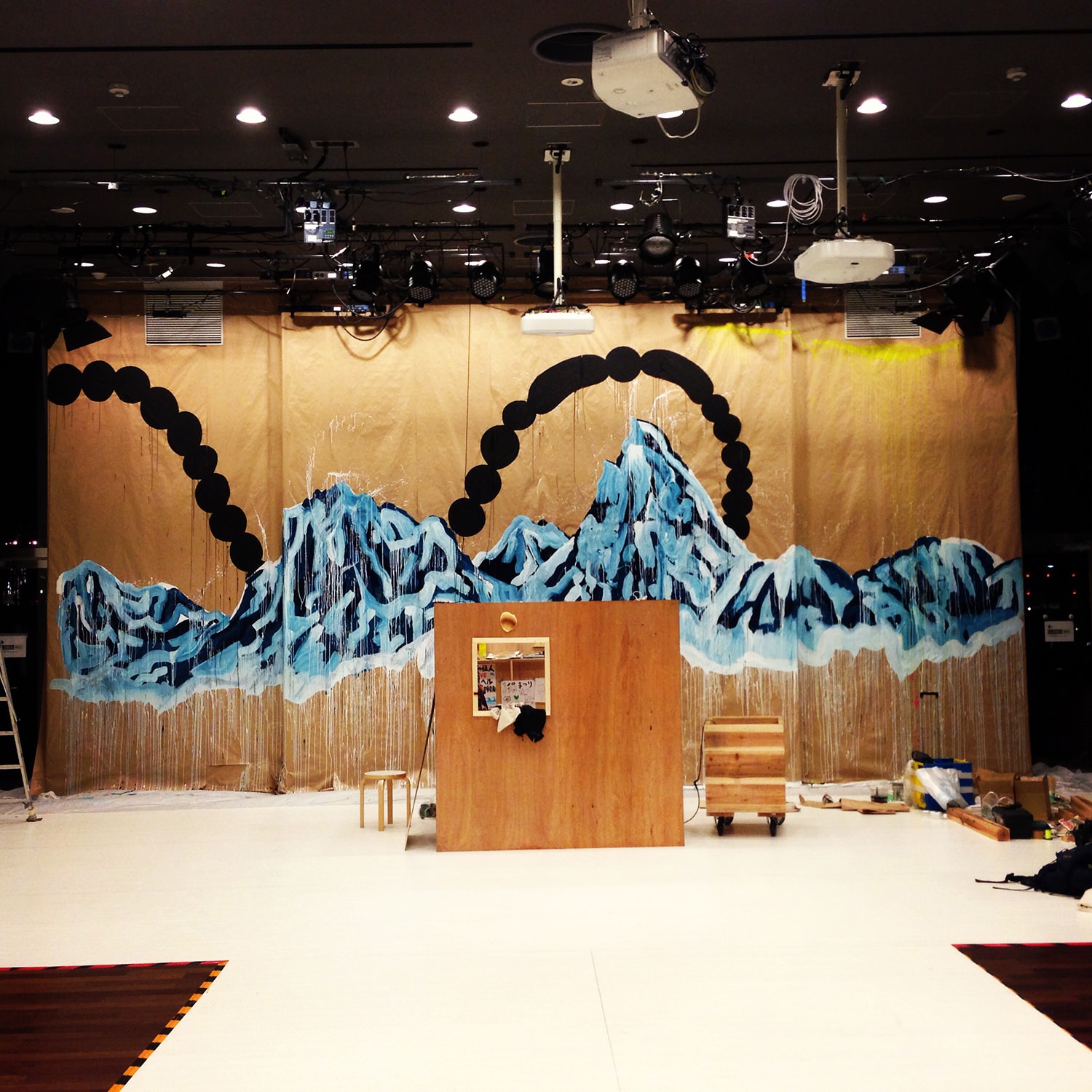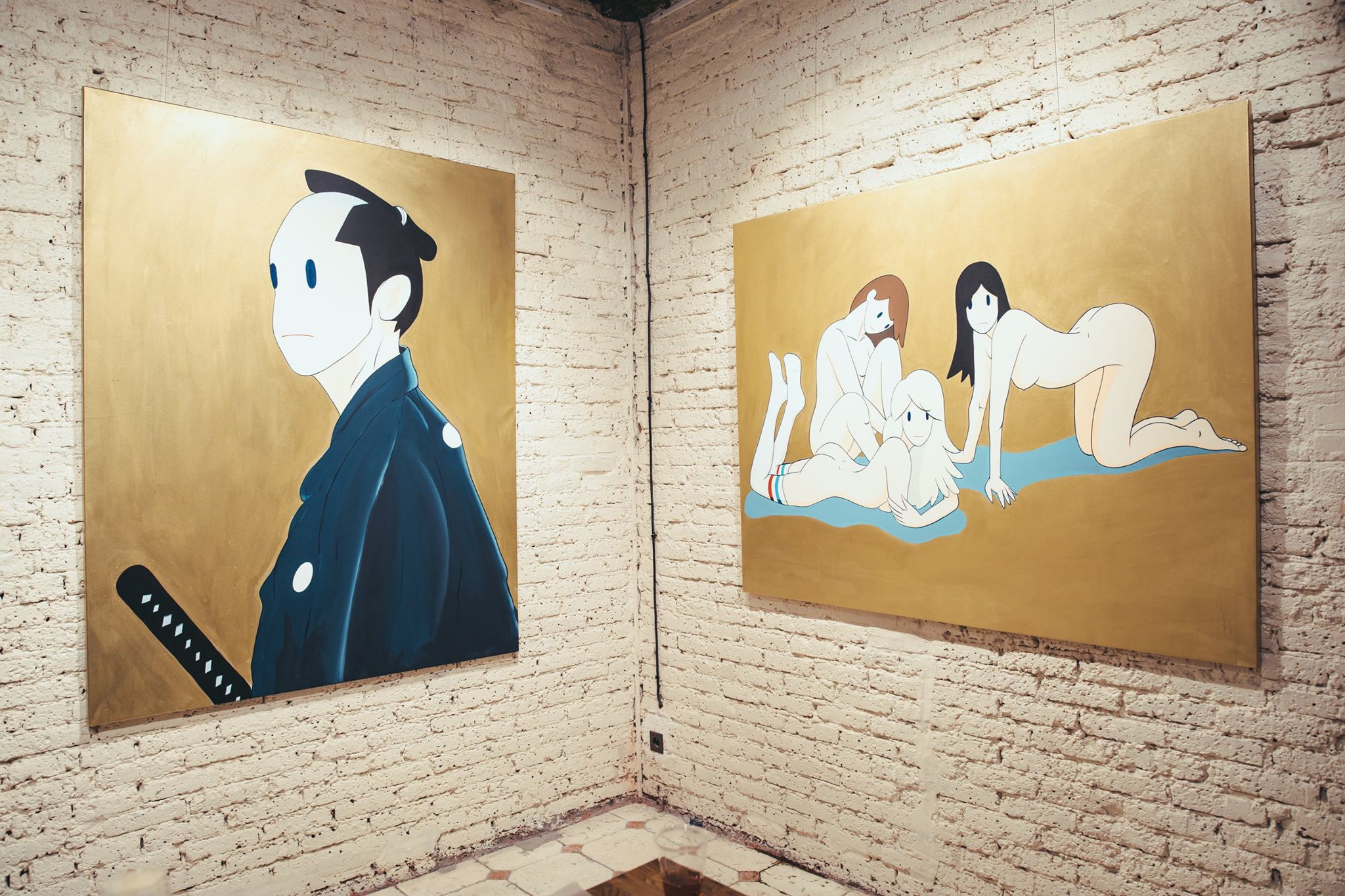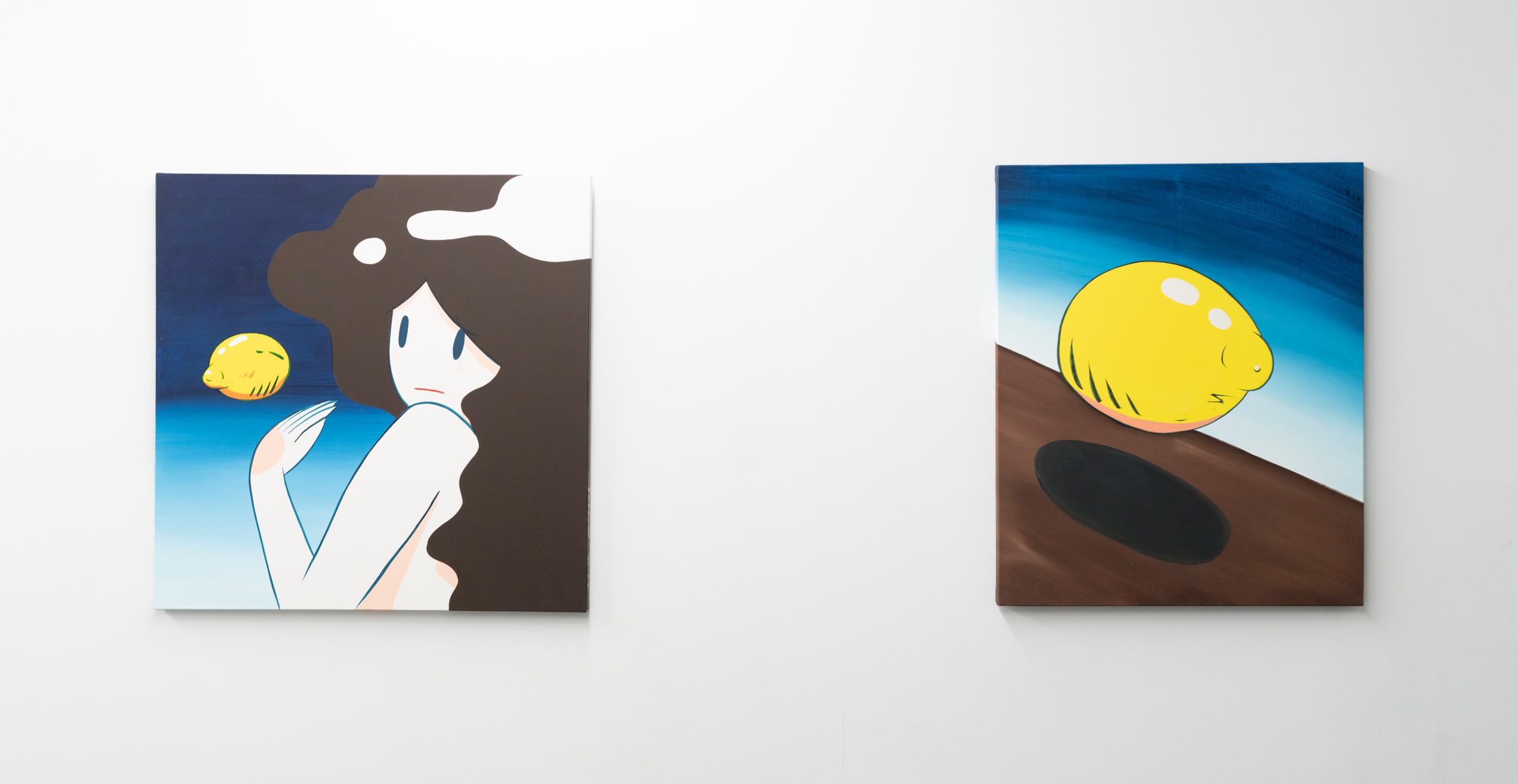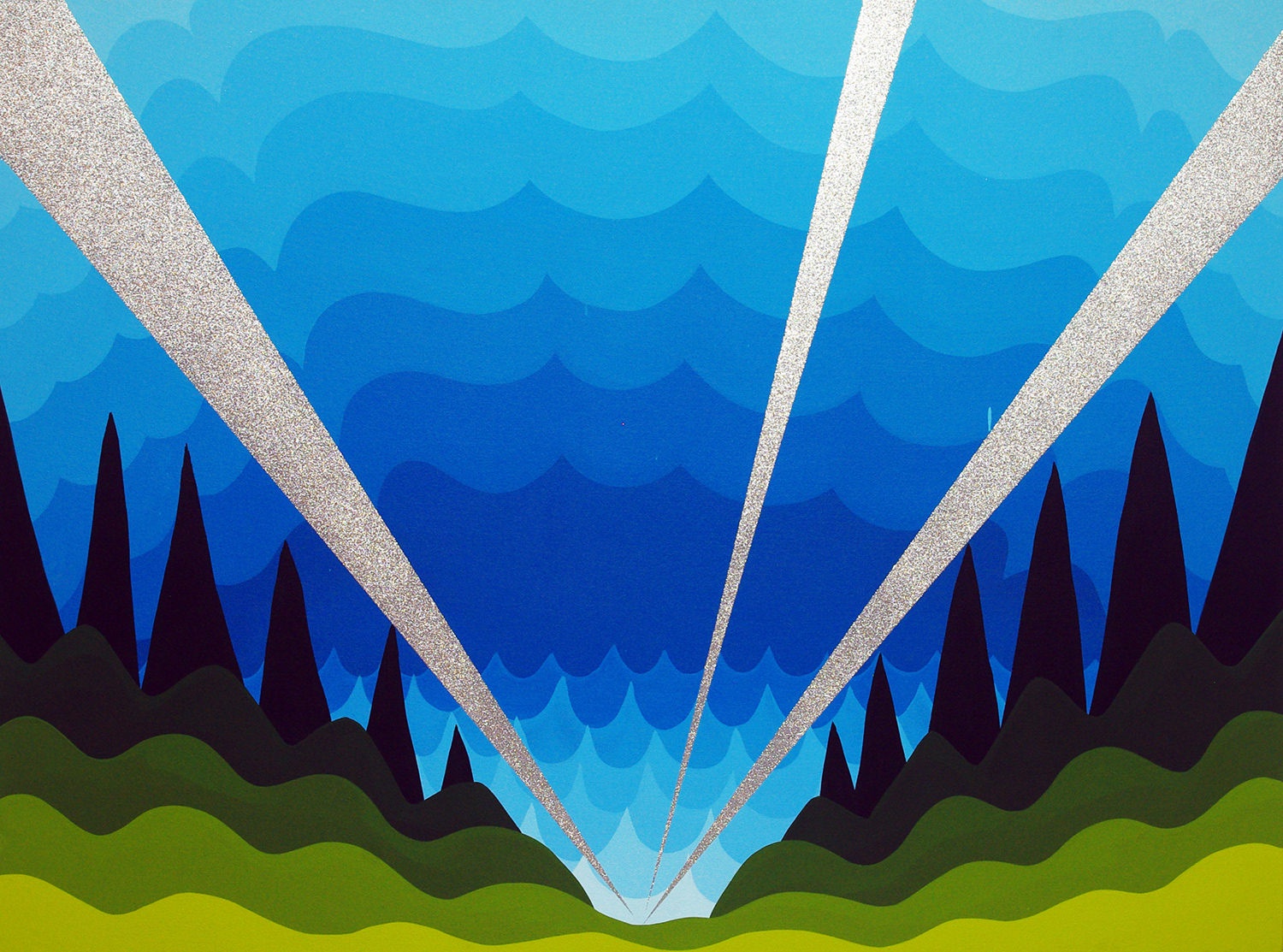
Takeru Amano (1977) is about 10 years old when he visits an exhibition of Keith Haring in a department store in Tokyo. What he witnesses makes a lasting impression. Haring uses the walls of the store to paint on. So instead of using paper, the young Takeru decides to spray-paint some flowers on the walls of the local swimming pool.
It marks the beginning of his colourful career.
Born with a pencil in his hand it was only normal he would become an artist. His whole family was drawing; it was part of their daily life. He didn’t need to go to art school. What could an art school teach him that he didn’t already know?
In 2000 however, Takeru went to New York with the idea to enter a school. He sent his portfolio, got in –“Come from tomorrow!” they told him -, but he never went. He felt he didn’t have time for it and instead explored the city and its culture, different from where he came from.

(solo exhibition - 2021: A Space Odyssey - Paris, 2021 ©️Sato Gallery)
Weren’t you interested in going to art school, just so you could meet some likeminded people?
"I wasn’t actually. Although I knew some artists of my generation had attended the school, I didn't feel attracted to the idea.
I moved from Yokohama [ed: his family home] to Tokyo, because I needed something different in my life. After, I moved from Tokyo to New York for the same reason. I had to break free from the routine I was in and what I mostly needed was time by myself."
After spending 4 years in New York, Takeru went back to Tokyo, where he started organizing his own exhibitions and art events in an almost non-stop pace.
You might wonder if Takeru could not find a proper gallery, but in those times, galleries were usually located in the high-end areas such as Ginza, and more often commercial rental spaces, than actual supporters of artists. Besides, these kind of clean places, didn’t fit the nature of his works.
For years, Takeru was not just an artist, but also an entrepreneur. He was his own gallerist, producer and (graphic) designer. He made art works, but also duvet covers, towels and lighters.
It was also in that time that he met Julien Sato. The two often worked together, creating events in which Takeru would do live paintings or VJ.

(Live painting by Takeru Amano - Tokyo, 2016)
What was it like to organize exhibitions in Tokyo at that time?
"I was always on the lookout for nice spaces to exhibit. Select shops, coffee houses or bars.
I never worked with a manager or gallery, but I collaborated with the owners of the space I’d use. They were usually my friends or people I got to know working together.
Now that I think of it, it has been 20 years since my first exhibition. Which was not in Tokyo, but in Bejing."
I was always on the lookout for nice spaces to exhibit. Select shops, coffee houses and bars.
In Japan, the art, brand and music industry merge into each other. Therefore Takeru was soon was involved in everything. Designing for fashion brands and at the same time making flyers for music events. Joining live paintings at night and making exhibitions during the day.
When I look at you, as Takeru Amano, the artist, it’s hard to picture you working for someone. Yet, you worked as a graphic designer for years.
"Until I was 30 years old I worked as a graphic designer on the side. But after I had a child I decided to quit and concentrate on paintings.
A child makes you see what is important. Besides, you don’t have any time to lose anymore!"

(solo exhibition - Icone Gold - Paris, 2017 ©️Sato Gallery)
Icons, they are what we like to call the subjects that appear on Takeru’s canvases or papers. Panda’s, mountains, women, lemons and candles: just to name a few. His world is unique and childlike, inspired by the Japanese culture of the end of the 20th century in which he grew up.
Takeru uses classical, philosophical or even mythological subjects and mixes them with neo-pop aesthetics and often a touch of humour. Think of a Venus with a lemon. Or the Virgin Mary sketched in bright neon colours. It can be surprising to see these well-known (Western) icons, from his Tokyo pop perspective, surreal even.
In 2020, he published his first art book, Icons. Since then, his career has soared, with international recognition and exhibitions all over the world. For the past year, he has been even more productive than he had already been over the last 20 years. Exhibition after exhibition, his Venuses are being shown all over the world.
In 2017, for his exhibition Icons II in Hong Kong, Takeru Amano wrote:
“Based on sketches I made in art classes in Paris and on photo’s of models I found on Instagram, I started painting scenes in which the modern woman replaces the ancient goddess.
As an image, it's just a nude. The face is very simple with only dots and lines. However, I carefully drew an emotional expression. Same for the body, drawn very simplistic. However, I made it in a way that the spectator can feel realism. The sharp contrasts create three-dimensionality.
As an Asian – Japanese - I like to recreate western paintings – mostly religious - that I have seen during my visits to Paris and Rome in recent years.
Western painters, within the realism movement, use light to create a three dimensional effect on a canvas. The Japanese on the other hand use lines to get this effect. Think about Leonardo Foujita, who used this technique. What he did was rare in the Western art, which made him unique in Paris.
When you go back in time even further, you find the same technique used by Katsushika Hokusai. While nowadays anime and manga are drawn the same way.
I hope people will feel the Japanese identity of their transformed icons when watching my work”

(solo exhibition - 2021: A Space Odyssey - Paris, 2021 ©️Sato Gallery)
When did you start painting nudes?
"That must have been 10 years ago."
What kind of women do you think of when you make a Venus?
"My ex-girlfriends."
Are you a nostalgic person?
"Yes, I am.
But these are difficult questions, because the answer is actually nothing mysterious.
In the end, there is no meaning. It’s like the “hanging Panda”, where I wrote how there is no religious, historical or political meaning behind any of it. Art is the people who watch the work. They add the meaning."
Art is the people who watch the work. They add the meaning.
Although there is not much meaning behind the creation of Venus, you have been making her for 10 years.
"To tell you the truth, I’m quite bored of making the Venus, but if I stop, people would get upset.
I would like to make other things - mountains mostly -, but if I say no, I won't be welcomed in Paris anymore [haha]. Its like saying 'no' to that.
At this moment, drawing is like a job to me. But within that frame, I create space for myself making sure I still enjoy it. I play with the colours; I add some landscapes and make some animals too.
I created Venus 10 years ago, but I can hardly control it at this point. In the past few months I have made about 350 works." [ed: this number includes all his works, not only Venus]
You have been very busy. Do you still have time to get inspired?
"Always. I feel inspired by my surrounding constantly. At this moment I don’t have much time, but it will come.
In order to feel, I need to change places. That's why I like to spend time in cities like Paris. Although with the recent changes, it has been hard to go abroad. Instead, I went on trips in Japan, to Nagano – the mountains - or to the sea.
But I do charge faster when I change the country. I have to visit Nagano 8 times before I am charged like when I visit Paris."

(Landscape by Takeru Amano ©️Sato Gallery)
